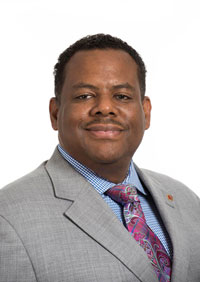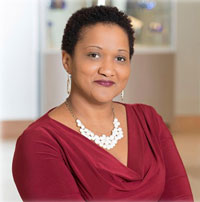Diverse supplier programs can bring cohesion to the community, not to mention a greater economic impact
Novant Health has a strong commitment to patient care, education and community services for those insured, under-insured and uninsured, and consistently delivers a significant impact to the health of its communities, says Kevin J. Price, director of supplier diversity and performance analytics. “The health of the communities we serve is our priority and a commitment we take very seriously.”
To that point, when Price stepped into his current role, he began talking with business owners, community leaders, chambers of commerce, elected officials and non-profit organizations, trying to make them aware of Novant Health’s commitment to building a more diverse supplier network. He educated them about the importance of diversity to the healthcare system.
“Novant Health’s patients reflect a diverse population, and we believe that to be a good partner in our community, we must do business with all segments of our community,” he says. “Supplier diversity is good business for Novant Health. Providing opportunities for diverse businesses to grow and develop enhances the remarkable patient experience and supports the economic base of the communities we serve. We strive to have vendors who match the demographic profiles of our patient population, and who can compete when it comes to pricing and service.”
Supplier diversity helps to make sure that people in the community have the ability to pay for their care, he adds. Prior to passage of the Affordable Care Act, more than 40 million people were uninsured, and many of them were among diverse populations. “We should have seen some connection to economic development.”
Consistent professional theme
It’s no surprise that Price looks for that connection. His career has gone through several phases, but it has one consistent theme: economic development.
“My career has been in stages; I’m in my fourth life,” he says. After he got out of the military, he went to college and contemplated a career in law. Instead, he got into government and community development work, working on affordable housing and other projects in North Carolina. “We were building 100 affordable houses a year,” as well as other facilities for the underserved.
On those projects, Price’s role was development, putting together plans, arranging financing. And that led to his third career – banking. He worked for three banks, the last one being a minority-owned institution, for which he worked on diversifying its portfolio into non-traditional businesses, including healthcare. That in turn led him to Novant Health.
“They asked me to come with them and start a supplier diversity program,” he recalls. “I didn’t know what that was.” But given his experience working for a minority-owned bank servicing primarily minority customers, “it was a cool transition.”
He started with Novant Health in 2006 and today, as director of supplier diversity, reports to the IDN’s chief diversity officer and chief of supply chain.
Field work
On the morning of the day the Journal of Healthcare Contracting spoke with Price, he met with potential suppliers at the meeting of the Hispanic Contractors Association of the Carolinas.
The fact that Price routinely participates in events such as the Hispanic Contractors Association conference, or that Novant Health hosted a Supplier Diversity Summit last year in partnership with the Latin American Chamber of Commerce of Charlotte (N.C), demonstrates an important point about successful supplier diversity programs: They do not operate on autopilot.
“That’s absolutely true,” he says. “No matter the industry, my counterparts and I have to be engaged in outreach. You can’t sit at a desk and be effective in this kind of work.”
Timothy Martin, manager, supplier diversity contracting & resource utilization, CHRISTUS Health, can attest to the same thing.
For Martin, a typical week consists of strategic planning, working with diversity suppliers, consulting with industry peers, educating team members and monitoring the progress of the supplier diversity program on the organization dashboard. In 2016, the IDN sponsored a number of diversity-oriented vendor fairs, including three in Louisiana, which drew a total of 261 suppliers.
A veteran materials management and purchasing professional, Martin was appointed to his current post in June 2015. “This new position was created after our senior leadership team saw the need to be more intentional in our efforts towards supplier diversity,” he says. “In my role, I’m fully dedicated to supplier diversity contracting and responsible for its strategic direction, which touches all business units. Ultimately, I accepted the new role because I wanted to be in a position to make a difference in the communities we serve.”
 Hosting fairs such as those in Louisiana takes work, “but they are so rewarding,” says Martin. “[They] support our outreach strategy. The goal is to educate our community suppliers on how to do business with CHRISTUS Health and other community partners/companies, and understand the importance of certification.” To make such events happen, he relies on support from others. In Louisiana, for example, KaZette Enterprises – one of CHRISTUS Health’s Diversity Supplier Council members – and the Louisiana district office of the U.S. Small Business Administration aided in the vendor fairs.
Hosting fairs such as those in Louisiana takes work, “but they are so rewarding,” says Martin. “[They] support our outreach strategy. The goal is to educate our community suppliers on how to do business with CHRISTUS Health and other community partners/companies, and understand the importance of certification.” To make such events happen, he relies on support from others. In Louisiana, for example, KaZette Enterprises – one of CHRISTUS Health’s Diversity Supplier Council members – and the Louisiana district office of the U.S. Small Business Administration aided in the vendor fairs.
Another component of CHRISTUS Health’s supplier diversity program is the Diversity Supplier Council. Created in 2014, the Council consists of minorities, women, and veterans who are small-business-certified suppliers, as well as suppliers that are nationally recognized for efforts to diversify their own supply chains. The Council offers members and their organizations access to CHRISTUS Health, mentoring and coaching, and opportunities to improve CHRISTUS Health’s vendor relationship management.
Education
Mentoring and coaching are two of the diversity director’s primary duties, according to those with whom JHC spoke.
Diversity vendors are often unfamiliar with the complexity of large organizations, such as health systems, says Martin. His education strategy “assures us that the suppliers we are doing business with obtain the business-savvy skills needed in order to be successful and grow within the communities they operate,” he says. “Such a program helps identify certain skills that might be lacking, and appropriate action plans can be put into place to address. Ultimately, we want our suppliers to succeed with us.”
Novant Health’s Price identifies three groups who need continuing education on diversity supplier issues: supply chain leaders, large healthcare suppliers, and diverse business owners.
“Supply chain leaders still have this thought that doing business with diverse suppliers will cost more money,” he says. “That’s simply not true.” It may be true that in some cases, the health system may need to make accommodations for smaller suppliers with smaller volumes of business, who may not always be able to offer best-in-class pricing. “That’s why it’s important to also engage large healthcare suppliers – which is the second piece.”
Due to the pressure to cut supply chain costs, many health systems gravitate toward big suppliers, who can offer greater market share and lower prices, says Price. “But as they do that, we are losing diverse suppliers.” To slow down that trend, Price and his team encourage buyers in the healthcare system to accommodate diverse companies as Tier 2 suppliers, and to enlist the big Tier 1 suppliers to help their smaller counterparts in the process. “Tier 1 suppliers have to own it with us,” he says. “Our customers (patients) and our communities are asking questions about how good a partner in the community we are. We think larger suppliers can be part of that equation.”
The third group is comprised of the diverse business owners themselves, many of whom need to learn how to successfully compete in the healthcare supply chain. “There are nuances in healthcare. I want to help them understand the players and build relationships with sourcing managers and others.”
In 2014, Novant Health partnered with the Tuck School of Business at Dartmouth, the Healthcare Supplier Diversity Alliance and Novation (now Vizient) in a week-long course designed to improve the business skills of diverse business owners and senior executives.
The idea arose several years earlier, as Price – who sat on Novation’s supplier diversity council – and others wrestled with how to engage more diverse suppliers in the healthcare supply chain. “We all had a common issue – that was, the pushback we were getting from the healthcare supply chain, who was asking, ‘Does this [diverse] supplier have healthcare experience?” he recalls.
“I had an old boss tell me, ‘No one is born with experience. Someone has to give it to you.’ For diverse suppliers, which never had the advantage of being engaged in the first place, being passed over for lack of experience was a challenge. “We wanted to level the playing field a little bit.
“If I sit down with a diverse supplier and a sourcing manager, and the sourcing manager asks, ‘Do you have a GPO agreement?’ and the suppliers says, ‘What’s a GPO?’ the conversation is over, mentally” he says. “We have to get these suppliers to the point of understanding what they’re getting engaged in and how to compete.”
Novant Health and Tuck School of Business have done two programs since, with better attendance than the first. With help from the Healthcare Supplier Diversity Alliance, Price and colleagues have collected scholarship money for diverse owners who can’t afford the cost of the week-long course.
“Once they leave the class, we want them to be connected to a community, so they can be nurtured and grow,” Price continues. For that reason, participants are encouraged to join the Healthcare Supplier Diversity Alliance.
Sustaining a strong program
Martin and Price agree that without CEO support, diversity programs will most likely fail over the long term.
“Supplier diversity is part of the DNA of CHRISTUS Health” says Martin. “Support of the program starts at the highest level in that of our CEO, Ernie Sadau, who also serves as our chief diversity officer. It’s that support from top management that ensures we have buy-in.”
Another “must” for a successful program is regular monitoring and reporting.
“It is my responsibility to track and report our progress to senior leadership on a monthly basis,” says Martin. “I work closely with the regional leaders to assure we’re meeting established goals. The goals are published monthly via company operational dashboard. Each region is held accountable for meeting their goal.”
For FY 2016, CHRISTUS Health set a target of 8 percent of total spend committed to diverse suppliers, and ended the year at 11.2 percent of spend related to diverse suppliers.
Price lists six keys to sustaining a vibrant diverse supplier program:
- Broaden the understanding or description of “supplier diversity” to include many groups. Rather than use the word “minority,” Price prefers “diversity,” because it includes women-owned businesses, veteran-owned businesses, LGBTQ-owned businesses, small businesses and others. When all these constituencies are drawn into a program, the community becomes stronger, as does the economic impact of the health system’s diversity program.
- Tie the business case to the health system’s strategic plan, goals, mission and values. “This goes back to our values of diversity and inclusion.” But words aren’t enough, he says. The health system has to quantify its goals and results.
- Encourage and insist on healthy competition. “Bringing in diverse suppliers keeps us in supply chain honest that we’re getting the best value and price.”
- Provide education, including programs such as those that Novant Health runs with Tuck School of Business.
- Communicate your strategies, goals and rationale, not only with suppliers, but with the community, with the health system staff, and even competitive health systems that share similar goals.
- Engage internal customers. Novant Health’s Diversity Action Committee and supplier work group are two ways to do so. “What motivates them are the stories we can tell, that this small business got started because of us, and now they are now patients of ours. That demonstrates community investment.”
Says Martin, “We continue to align our efforts with our mission – To extend the healing ministry of Jesus Christ – and ensure supplier diversity is a part of everything we do.”
Action steps
To increase supplier diversity, a healthcare organization should consider these steps:
- Define goals for a supplier diversity program and draft a clear mission statement. Create a code of conduct that ensures fair access to all suppliers.
- Incorporate these goals into the hospital’s or health system’s strategic plan and include specific targets for diversity spending. Frame supplier diversity goals as strategic and business imperatives, rather than simply “the right thing to do.”
- Communicate with your group purchasing organization to ensure its practices reflect your hospital’s goals.
- Consider opportunities to diversify other hospital contracts, such as those for advertising and marketing.
- Ensure that at least one minority candidate is always considered for a supplier position.
- Appoint a champion within the organization who will be accountable for implementing supplier diversity and tracking performance goals and dollars spent on diverse suppliers.
- Cultivate relationships with diverse suppliers through favorable financial terms, technical and managerial services and educational seminars.
- If your hospital or health system isn’t doing so already, consider working with a group purchasing organization to gain access to a wide network of diverse suppliers.
- Avoid framing the supplier diversity program as a quota system or social program. Instead, emphasize its importance as a business strategy that will provide a competitive advantage to the organization.
Source: “Increasing Supplier Diversity in Health Care,” Health Research & Educational Trust, Chicago, Ill. (Sept 2015), www.hpoe.org/supplierdiversity



Nice article. One of the comments you made in the article was, “…supports the economic base of the communities we serve” caught my attention. I work for the Veterans Health Administration of the US Department of Veterans Affairs and have found that with the creation of Prime Vendors, comments from local suppliers have been pushed aside for a national or regional solution. Such a solution is not supportive of local economic initiatives. While diversity is important, it is couched within the universe of a national buying office and not diversity at the local level. Of course contracting will be different between goods and services.
Have you found this in the non-governmental healthcare industry, the trade off between National GPO’s vs local vendors and how is supporting the local economy measured or is it? Thank you!